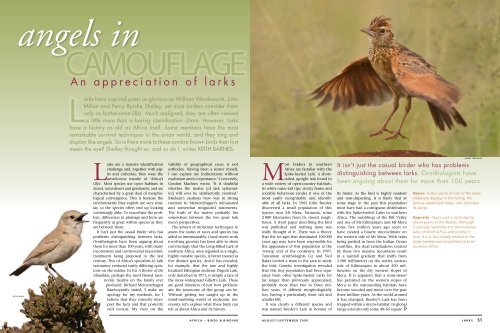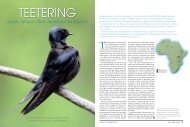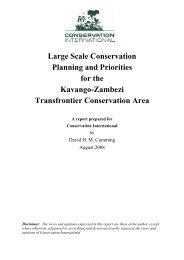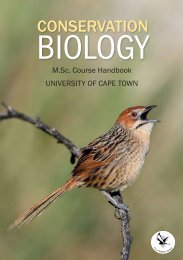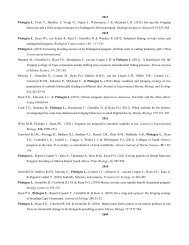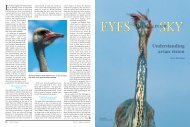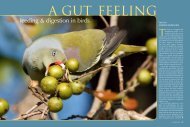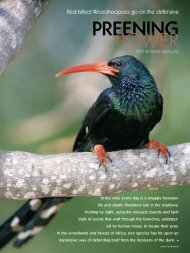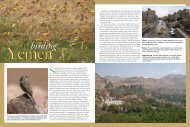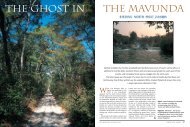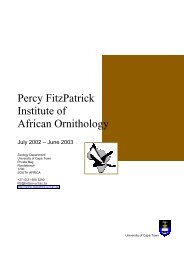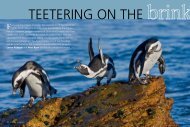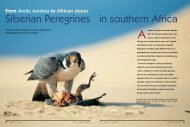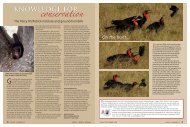Angels in camouflage: an appreciation of larks - Percy FitzPatrick ...
Angels in camouflage: an appreciation of larks - Percy FitzPatrick ...
Angels in camouflage: an appreciation of larks - Percy FitzPatrick ...
You also want an ePaper? Increase the reach of your titles
YUMPU automatically turns print PDFs into web optimized ePapers that Google loves.
<strong>an</strong>gels <strong>in</strong><br />
CAMOUFLAGE<br />
An <strong>appreciation</strong> <strong>of</strong> <strong>larks</strong><br />
Larks have <strong>in</strong>spired poets as glorious as William Wordsworth, John<br />
Milton <strong>an</strong>d <strong>Percy</strong> Bysshe Shelley, yet most birders consider them<br />
only as bothersome LBJs. Much maligned, they are <strong>of</strong>ten viewed<br />
as little more th<strong>an</strong> a bor<strong>in</strong>g identification chore. However, <strong>larks</strong><br />
have a history as old as Africa itself. Some members have the most<br />
remarkable survival techniques <strong>in</strong> the avi<strong>an</strong> world, <strong>an</strong>d they s<strong>in</strong>g <strong>an</strong>d<br />
display like <strong>an</strong>gels. So is there more to these sombre brown birds th<strong>an</strong> first<br />
meets the eye Shelley thought so, <strong>an</strong>d so do I, writes KEITH BARNES.<br />
albert fronem<strong>an</strong><br />
peter ry<strong>an</strong><br />
Larks are a massive identification<br />
challenge <strong>an</strong>d, together with pipits<br />
<strong>an</strong>d cisticolas, they wear the<br />
unwelcome m<strong>an</strong>tle <strong>of</strong> ‘Africa’s<br />
LBJs’. Most species use open habitats <strong>in</strong><br />
desert, semi-desert <strong>an</strong>d grassl<strong>an</strong>ds, <strong>an</strong>d are<br />
characterised by a great deal <strong>of</strong> morphological<br />
convergence. This is because the<br />
environments they exploit are very similar,<br />
so the species <strong>of</strong>ten end up look<strong>in</strong>g<br />
confus<strong>in</strong>gly alike. To exacerbate the problem,<br />
differences <strong>in</strong> plumage <strong>an</strong>d form are<br />
frequently as great with<strong>in</strong> species as they<br />
are between them.<br />
It isn’t just the casual birder who has<br />
problems dist<strong>in</strong>guish<strong>in</strong>g between <strong>larks</strong>.<br />
Ornithologists have been argu<strong>in</strong>g about<br />
them for more th<strong>an</strong> 100 years, with m<strong>an</strong>y<br />
<strong>in</strong>consistent <strong>an</strong>d controversial taxonomic<br />
treatments be<strong>in</strong>g proposed <strong>in</strong> the last<br />
century. Two <strong>of</strong> Africa’s specialists <strong>in</strong> lark<br />
taxonomy ventured vastly differ<strong>in</strong>g op<strong>in</strong>ions<br />
on the matter. In his A Review <strong>of</strong> the<br />
Alaudidae, perhaps the most flawed taxonomic<br />
treatise on the family ever<br />
produced, Richard Me<strong>in</strong>ertzhagen<br />
flamboy<strong>an</strong>tly stated, ‘I make no<br />
apology for my methods, for I<br />
believe that they correctly <strong>in</strong>terpret<br />
the facts <strong>an</strong>d that posterity<br />
will concur. My view on the<br />
validity <strong>of</strong> geographical races is not<br />
orthodox. Hav<strong>in</strong>g been a s<strong>in</strong>ner myself,<br />
I c<strong>an</strong> expiate my <strong>in</strong>discretions without<br />
exultation <strong>an</strong>d <strong>in</strong> repent<strong>an</strong>ce.’ Conversely,<br />
Gordon Macle<strong>an</strong> wrote, ‘It is doubtful<br />
whether the matter [<strong>of</strong> lark systematics]<br />
will ever be satisfactorily resolved.’<br />
Macle<strong>an</strong>’s cautious view was <strong>in</strong> strong<br />
contrast to Me<strong>in</strong>ertzhagen’s self-assured<br />
<strong>an</strong>d somewhat misguided statements.<br />
The truth <strong>of</strong> the matter probably lies<br />
somewhere between the two great lark<br />
men’s perspectives.<br />
The advent <strong>of</strong> molecular techniques to<br />
assess the status <strong>of</strong> races <strong>an</strong>d species has<br />
aided us immeasurably. Good recent work<br />
<strong>in</strong>volv<strong>in</strong>g genetics has been able to show<br />
conv<strong>in</strong>c<strong>in</strong>gly that the Long-billed Lark <strong>of</strong><br />
southern Africa, once regarded as a s<strong>in</strong>gle,<br />
highly variable species, is better treated as<br />
five dist<strong>in</strong>ct species. And it has revealed,<br />
for example, that the rare <strong>an</strong>d highly<br />
localised Ethiopi<strong>an</strong> endemic Degodi Lark,<br />
only described <strong>in</strong> 1971, is simply a race <strong>of</strong><br />
the more widespread Gillett’s Lark. These<br />
are good <strong>in</strong>st<strong>an</strong>ces <strong>of</strong> just how problematic<br />
the taxonomy <strong>of</strong> this group c<strong>an</strong> be.<br />
Without gett<strong>in</strong>g too caught up <strong>in</strong> the<br />
m<strong>in</strong>d-numb<strong>in</strong>g world <strong>of</strong> molecular taxonomy,<br />
let’s explore what these birds c<strong>an</strong><br />
tell us about Africa <strong>an</strong>d its history.<br />
Most birders <strong>in</strong> southern<br />
Africa are familiar with the<br />
Spike-heeled Lark. A shorttailed,<br />
upright lark found <strong>in</strong><br />
a wide variety <strong>of</strong> open-country habitats,<br />
its white outer-tail tips, stocky frame <strong>an</strong>d<br />
sociable behaviour render it one <strong>of</strong> the<br />
most easily recognisable <strong>an</strong>d identifiable<br />
<strong>of</strong> all <strong>larks</strong>. In 1965 John Beesley<br />
discovered a small population <strong>of</strong> this<br />
species near Mt Meru, T<strong>an</strong>z<strong>an</strong>ia, some<br />
2 000 kilometres from its closest neighbours.<br />
A short paper describ<strong>in</strong>g the bird<br />
was published <strong>an</strong>d noth<strong>in</strong>g more was<br />
really thought <strong>of</strong> it. There was a theory<br />
that the ice ages that dom<strong>in</strong>ated 100 000<br />
years ago may have been responsible for<br />
the appear<strong>an</strong>ce <strong>of</strong> this population at the<br />
‘wrong’ end <strong>of</strong> the cont<strong>in</strong>ent. In 1997,<br />
T<strong>an</strong>z<strong>an</strong>i<strong>an</strong> ornithologists Liz <strong>an</strong>d Neil<br />
Baker <strong>in</strong>vited a team to the area to study<br />
the bird. Genetic <strong>in</strong>vestigation revealed<br />
that this t<strong>in</strong>y population had been separated<br />
from other Spike-heeled Larks for<br />
far longer th<strong>an</strong> previously appreciated,<br />
probably more th<strong>an</strong> two to three million<br />
years. It differed morphologically<br />
too, hav<strong>in</strong>g a particularly short tail <strong>an</strong>d<br />
smaller bill.<br />
It was clearly a different species <strong>an</strong>d<br />
was named Beesley’s Lark <strong>in</strong> honour <strong>of</strong><br />
It isn’t just the casual birder who has problems<br />
dist<strong>in</strong>guish<strong>in</strong>g between <strong>larks</strong>. Ornithologists have<br />
been argu<strong>in</strong>g about them for more th<strong>an</strong> 100 years<br />
its f<strong>in</strong>der. As the bird is highly resident<br />
<strong>an</strong>d non-dispers<strong>in</strong>g, it is likely that at<br />
some stage <strong>in</strong> the past this population<br />
must have had a contiguous distribution<br />
with the Spike-heeled Larks <strong>in</strong> southern<br />
Africa. The rumbl<strong>in</strong>gs <strong>of</strong> the Rift Valley<br />
<strong>an</strong>d rise <strong>of</strong> Mt Kilim<strong>an</strong>jaro <strong>an</strong>d Mt Meru<br />
some five million years ago seem to<br />
have created a bizarre microclimate on<br />
the western side <strong>of</strong> Mt Meru. With ra<strong>in</strong>s<br />
be<strong>in</strong>g pushed <strong>in</strong> from the Indi<strong>an</strong> Oce<strong>an</strong><br />
coastl<strong>in</strong>e, the dual ra<strong>in</strong>shadows created<br />
by these two massive mounta<strong>in</strong>s result<br />
<strong>in</strong> a ra<strong>in</strong>fall gradient that shifts from<br />
3 500 millimetres on the wetter, eastern<br />
side <strong>of</strong> Kilim<strong>an</strong>jaro to about 500 millimetres<br />
on the dry western slopes <strong>of</strong><br />
Meru. It is apparent that a m<strong>in</strong>i-desert<br />
has persisted on the western slopes <strong>of</strong><br />
Meru as the surround<strong>in</strong>g habitats have<br />
become wooded <strong>an</strong>d moist over the past<br />
three million years. As the world around<br />
it has ch<strong>an</strong>ged, Beesley’s Lark has been<br />
trapped with<strong>in</strong> a micro-habitat: its global<br />
r<strong>an</strong>ge extends only some 40–65 square <br />
Above In the course <strong>of</strong> one <strong>of</strong> the more<br />
elaborate displays <strong>in</strong> the family, the<br />
Rufous-naped Lark leaps, calls <strong>an</strong>d claps<br />
its w<strong>in</strong>gs.<br />
Opposite Gray’s Lark is restricted to<br />
gravel pla<strong>in</strong>s <strong>in</strong> the Namib. Although<br />
it strongly resembles the Ammom<strong>an</strong>es<br />
<strong>larks</strong> <strong>of</strong> North Africa <strong>an</strong>d southern<br />
Asia, it is <strong>in</strong> fact closely related to the<br />
Spike-heeled <strong>an</strong>d Long-billed <strong>larks</strong> <strong>of</strong><br />
southern Africa.<br />
50 <strong>larks</strong> africa – birds & bird<strong>in</strong>g<br />
august/september 2009<br />
<strong>larks</strong> 51
mart<strong>in</strong> benadie<br />
n<strong>an</strong>cy bell<br />
Larks <strong>of</strong>fer us a unique snapshot <strong>of</strong><br />
Africa’s history, as they are <strong>an</strong> <strong>an</strong>cient<br />
group <strong>of</strong> birds that c<strong>an</strong> trace some <strong>of</strong> the<br />
cont<strong>in</strong>ent’s earliest geological events<br />
kilometres <strong>an</strong>d probably no more th<strong>an</strong><br />
100 <strong>in</strong>dividuals rema<strong>in</strong>. It is literally on<br />
the br<strong>in</strong>k <strong>of</strong> natural ext<strong>in</strong>ction.<br />
But m<strong>an</strong>y <strong>larks</strong> have <strong>in</strong>credibly small<br />
r<strong>an</strong>ges <strong>an</strong>d persist <strong>in</strong> m<strong>in</strong>uscule patches <strong>of</strong><br />
habitat. The genus Heteromirafra, compris<strong>in</strong>g<br />
South Africa’s Critically End<strong>an</strong>gered<br />
Rudd’s Lark, Ethiopia’s Sidamo Lark <strong>an</strong>d<br />
Somalia’s Archer’s Lark, is the most obvious<br />
group. With r<strong>an</strong>ges scattered widely<br />
across the cont<strong>in</strong>ent, each <strong>of</strong> these species<br />
occupies <strong>an</strong> exceptionally small global<br />
r<strong>an</strong>ge. Genetic work has revealed<br />
that Heteromirafra possibly represents<br />
<strong>an</strong> <strong>an</strong>cient l<strong>in</strong>eage that is slowly be<strong>in</strong>g<br />
replaced <strong>an</strong>d outcompeted by more<br />
dom<strong>in</strong><strong>an</strong>t <strong>larks</strong>.<br />
Larks <strong>of</strong>fer us a unique snapshot <strong>of</strong><br />
Africa’s history, as they are <strong>an</strong> <strong>an</strong>cient<br />
group <strong>of</strong> birds that c<strong>an</strong> trace some <strong>of</strong> the<br />
cont<strong>in</strong>ent’s early geological events. They<br />
are dom<strong>in</strong><strong>an</strong>t <strong>in</strong> Africa’s r<strong>an</strong>gel<strong>an</strong>ds <strong>an</strong>d,<br />
<strong>of</strong> all the bird families adapted to this<br />
habitat, they are also the most speciesrich<br />
group, with the most complex distribution<br />
patterns. All <strong>of</strong> these factors<br />
assist researchers’ <strong>in</strong>vestigations <strong>in</strong>to the<br />
poorly studied r<strong>an</strong>gel<strong>an</strong>ds.<br />
Of the 96 species <strong>of</strong> <strong>larks</strong> <strong>in</strong> the world,<br />
some 78 are found <strong>in</strong> Africa. They are<br />
concentrated <strong>in</strong> two ma<strong>in</strong> areas <strong>in</strong> particular:<br />
the south-west (South Africa,<br />
Botsw<strong>an</strong>a <strong>an</strong>d Namibia) <strong>an</strong>d the northeast<br />
(Ethiopia, Kenya <strong>an</strong>d Somalia), with<br />
26 <strong>an</strong>d 23 species respectively be<strong>in</strong>g<br />
endemic to these zones. Some theories<br />
propose that over m<strong>an</strong>y millions <strong>of</strong> years<br />
these two areas were connected (maybe<br />
a number <strong>of</strong> times) by <strong>an</strong> arid corridor,<br />
<strong>an</strong>d that <strong>in</strong> the process <strong>larks</strong> dispersed<br />
<strong>an</strong>d speciated across this corridor.<br />
Genetic research has turned up some<br />
fasc<strong>in</strong>at<strong>in</strong>g evidence <strong>in</strong> this regard. It<br />
seems that true desert <strong>larks</strong> did not disperse<br />
via the arid corridor. Instead, they<br />
appear to have evolved from neighbour<strong>in</strong>g<br />
<strong>larks</strong> <strong>an</strong>d have undergone radically<br />
divergent morphological evolution.<br />
A good example from southern Africa<br />
is Gray’s Lark. For m<strong>an</strong>y years it was<br />
thought to be closely related to the<br />
Ammom<strong>an</strong>es desert <strong>larks</strong> <strong>of</strong> North Africa<br />
because <strong>of</strong> their unc<strong>an</strong>ny mor phological<br />
similarity. However, Gray’s Lark’s closest<br />
relatives are other southern Afric<strong>an</strong><br />
<strong>larks</strong>, <strong>in</strong>clud<strong>in</strong>g the very dis similar Spikeheeled<br />
<strong>an</strong>d Long-billed lark complexes.<br />
Unlike true desert <strong>larks</strong>, semi-desert <strong>an</strong>d<br />
grassl<strong>an</strong>d <strong>larks</strong> do seem to have used<br />
Arid corridor<br />
the arid corridor for dispersal <strong>an</strong>d there<br />
are closely related species that occur at<br />
opposite ends <strong>of</strong> it, such as the Foxy Lark<br />
<strong>in</strong> the north <strong>an</strong>d the Fawn-coloured Lark<br />
<strong>in</strong> the south.<br />
While the study <strong>of</strong> <strong>larks</strong> is<br />
able to reveal <strong>in</strong>trigu<strong>in</strong>g<br />
patterns about the evolution<br />
<strong>of</strong> Africa’s arid zones,<br />
these hardy little birds also have <strong>an</strong> array<br />
<strong>of</strong> features that enable them to master<br />
the dry country.<br />
Feathers are the first. Larks are dullcoloured<br />
birds that have conservative<br />
plumage coloration <strong>an</strong>d patterns. There<br />
is a good reason for this: they require<br />
camou flage. In some <strong>larks</strong>, the colour <strong>of</strong><br />
their plumage is l<strong>in</strong>ked to that <strong>of</strong> the soil,<br />
<strong>an</strong>d their streak<strong>in</strong>g pattern is related to<br />
ve getation density. As r<strong>an</strong>gel<strong>an</strong>d specialists,<br />
these birds are placed under severe<br />
pressure from aerial predators, with<br />
falcons, kestrels <strong>an</strong>d sparrowhawks frequently<br />
overhead. When a lark is alarmed<br />
by a dist<strong>an</strong>t threat, it freezes, rely<strong>in</strong>g on<br />
its cryptic plumage to best effect. Only<br />
when a threat is extremely close does the<br />
bird flush.<br />
There are two ma<strong>in</strong> types <strong>of</strong> lark <strong>camouflage</strong><br />
plumage: generalised <strong>an</strong>d specialised.<br />
Generalised plumage comprises<br />
a mixture <strong>of</strong> colours with dark streak<strong>in</strong>g<br />
or spott<strong>in</strong>g on the feathers. This <strong>of</strong>fers<br />
crypsis <strong>an</strong>ywhere <strong>an</strong>d is particularly useful<br />
<strong>in</strong> a wide r<strong>an</strong>ge <strong>of</strong> vegetation backgrounds.<br />
Because <strong>of</strong> their varied habitat<br />
use, almost all migr<strong>an</strong>t <strong>an</strong>d nomadic<br />
<strong>larks</strong> (for example, the Somali Short-toed<br />
Lark) have generalised <strong>camouflage</strong>.<br />
Specialised <strong>camouflage</strong> tends to be<br />
uniform <strong>an</strong>d <strong>in</strong>volves a very close colour<br />
match with the tones <strong>of</strong> the bird’s<br />
favoured habitat. An excellent example <br />
The hypothetical arid corridor that may<br />
have persisted dur<strong>in</strong>g the ice ages <strong>an</strong>d at<br />
other periods dur<strong>in</strong>g Africa’s history obviously<br />
impacted on the evolution <strong>of</strong> some<br />
<strong>larks</strong>. However, its effect was limited for<br />
other groups, which seem to have evolved<br />
more <strong>in</strong> situ.<br />
Opposite, top The Dune Lark has<br />
plumage that matches almost exactly the<br />
substrate on which it lives <strong>in</strong> the Namib<br />
s<strong>an</strong>d-dune sea. It c<strong>an</strong> survive without<br />
freest<strong>an</strong>d<strong>in</strong>g water <strong>an</strong>d derives its water<br />
requirements from its food.<br />
Opposite, middle, left The Spike-heeled<br />
Lark is a species <strong>of</strong> open grassl<strong>an</strong>d <strong>an</strong>d<br />
semi-desert <strong>in</strong> southern Africa. Unusually,<br />
it breeds cooperatively <strong>an</strong>d uses aardvark<br />
burrows for shelter <strong>in</strong> hot climates.<br />
Opposite, middle, right The Sidamo<br />
Lark belongs to Heteromirafra, a genus<br />
apparently <strong>in</strong> ecological retreat, with all its<br />
members hav<strong>in</strong>g m<strong>in</strong>ute r<strong>an</strong>ges scattered<br />
across Africa.<br />
Opposite, bottom Gillett’s Lark, a scarce<br />
local resident <strong>in</strong> arid country <strong>in</strong> northeastern<br />
Africa, is related to the Karoo<br />
<strong>an</strong>d Dune <strong>larks</strong> <strong>of</strong> southern Africa – a<br />
good example <strong>of</strong> speciation along the<br />
arid corridor.<br />
august/september 2009<br />
<strong>larks</strong><br />
53<br />
keith barnes (2)
peter ry<strong>an</strong><br />
EDWIN WINKEL (2)<br />
Of the 96 species <strong>of</strong> <strong>larks</strong><br />
<strong>in</strong> the world, some 78 are<br />
found <strong>in</strong> Africa<br />
is the Dune Lark, which is resident <strong>in</strong> the<br />
open terra<strong>in</strong> <strong>of</strong> the Namib s<strong>an</strong>d-dune sea.<br />
Despite lack<strong>in</strong>g cover, the Dune Lark c<strong>an</strong><br />
virtually v<strong>an</strong>ish from sight when it is stationary<br />
on bare s<strong>an</strong>d. In <strong>an</strong> experiment,<br />
<strong>an</strong> ornithologist tried to chase <strong>an</strong> <strong>in</strong>dividual<br />
lark with specialised plumage onto a<br />
nearby substrate that would make it more<br />
conspicuous. The bird refused to rema<strong>in</strong><br />
on the adjo<strong>in</strong><strong>in</strong>g substrate, preferr<strong>in</strong>g to<br />
take flight <strong>an</strong>d l<strong>an</strong>d where its plumage<br />
coloration matched the ground.<br />
When <strong>larks</strong> take flight, their <strong>camouflage</strong><br />
<strong>of</strong>ten breaks down. M<strong>an</strong>y species<br />
have red or white patches <strong>in</strong> the w<strong>in</strong>gs or<br />
tail that act as signals for communication<br />
<strong>an</strong>d, frequently, for display purposes. The<br />
white outer-tail feathers, for example, are<br />
<strong>of</strong>ten more noticeable from below, where<br />
a female might be watch<strong>in</strong>g, th<strong>an</strong> they<br />
are from above, whence a predator may<br />
approach.<br />
As a family, <strong>larks</strong> have arguably<br />
the most variable bills <strong>of</strong> <strong>an</strong>y<br />
Afri c<strong>an</strong> passer<strong>in</strong>es. Those species<br />
us<strong>in</strong>g s<strong>of</strong>ter substrates have<br />
longer, down-curved bills for digg<strong>in</strong>g<br />
<strong>an</strong>d tend to be <strong>in</strong>sectivorous. Seed-eat<strong>in</strong>g<br />
<strong>larks</strong> have smaller, f<strong>in</strong>ch-like bills, <strong>an</strong>d the<br />
Thick-billed Lark has a massive, chunky<br />
bill more befitt<strong>in</strong>g a grosbeak. This<br />
immense variability helps <strong>larks</strong> exploit<br />
virtually <strong>an</strong>y food source available <strong>in</strong> their<br />
meagre environments. Even with<strong>in</strong> species,<br />
bill proportions c<strong>an</strong> differ extraord<strong>in</strong>arily;<br />
<strong>in</strong> the Raso Lark they diverge so<br />
signific<strong>an</strong>tly that the males <strong>an</strong>d females<br />
c<strong>an</strong> practically forage as different species.<br />
The longer-billed males dig <strong>an</strong>d probe for<br />
food while the females use their smaller<br />
bills to flip pebbles. The completely different<br />
forag<strong>in</strong>g strategies help this Critically<br />
End<strong>an</strong>gered species to exploit more fully<br />
the limited resources on its m<strong>in</strong>ute, twosquare-kilometre<br />
Raso Islet home.<br />
Larks c<strong>an</strong> tolerate massive environmental<br />
extremes. The Greater Hoopoe Lark<br />
c<strong>an</strong> exist <strong>in</strong> <strong>an</strong> environment that receives<br />
less th<strong>an</strong> 50 millimetres <strong>of</strong> ra<strong>in</strong> a year <strong>an</strong>d<br />
reaches temperatures <strong>of</strong> more th<strong>an</strong> 50 °C<br />
<strong>in</strong> summer. Conversely, the Horned Lark<br />
survives <strong>in</strong> the Atlas Mounta<strong>in</strong>s, where<br />
temperatures plummet below -15 °C on<br />
mid-w<strong>in</strong>ter nights.<br />
Desert-dwell<strong>in</strong>g <strong>larks</strong> have developed<br />
several impressive physiological adaptations<br />
that enable them to survive <strong>in</strong><br />
parched l<strong>an</strong>ds. Individual <strong>larks</strong> are able<br />
to use less energy dur<strong>in</strong>g summer by<br />
lower<strong>in</strong>g their metabolic rate by up to<br />
30 per cent. At this time <strong>of</strong> year their food<br />
dem<strong>an</strong>ds are lower <strong>an</strong>d they reduce the<br />
size <strong>of</strong> their <strong>in</strong>ternal org<strong>an</strong>s (<strong>in</strong>clud<strong>in</strong>g<br />
liver <strong>an</strong>d kidneys) to suppress their energy<br />
requirements. As there is virtually no<br />
free-st<strong>an</strong>d<strong>in</strong>g water <strong>in</strong> the deserts where<br />
some <strong>of</strong> these species live, how do they<br />
survive These <strong>larks</strong> lose water through<br />
evaporation at a rate much lower th<strong>an</strong><br />
that expected from similar-sized birds<br />
<strong>in</strong> other families. They are also capable<br />
<strong>of</strong> reabsorb<strong>in</strong>g a considerable amount<br />
<strong>of</strong> water <strong>in</strong> the <strong>in</strong>test<strong>in</strong>e when water is<br />
scarce. Several species are so efficient<br />
at reta<strong>in</strong><strong>in</strong>g water that they have never<br />
been observed dr<strong>in</strong>k<strong>in</strong>g. It is thought<br />
that some species ga<strong>in</strong> all their water<br />
requirements through their food, by<br />
eat<strong>in</strong>g moist <strong>in</strong>sects or the fleshy parts<br />
<strong>of</strong> pl<strong>an</strong>ts, or through the oxidation <strong>of</strong><br />
seeds. In extreme desert conditions, the<br />
birds actively seek out items that would<br />
improve their water bal<strong>an</strong>ce, <strong>an</strong>d have<br />
even been seen dr<strong>in</strong>k<strong>in</strong>g dew.<br />
With so much effort <strong>in</strong>vested <strong>in</strong><br />
reta<strong>in</strong><strong>in</strong>g water, stay<strong>in</strong>g cool <strong>an</strong>d keep<strong>in</strong>g<br />
their metabolic rates <strong>in</strong> check, <strong>larks</strong><br />
have had to adopt a number <strong>of</strong> unusual<br />
behavi ours. Some species, such as Gray’s<br />
Lark, specialise <strong>in</strong> display<strong>in</strong>g only <strong>in</strong> the<br />
pre-dawn <strong>an</strong>d post-dusk light to reduce<br />
energy expenditure. All <strong>larks</strong> try to rest<br />
dur<strong>in</strong>g the hot <strong>an</strong>d parched midday.<br />
Perch<strong>in</strong>g on bushes to avoid the hot<br />
ground <strong>an</strong>d <strong>in</strong>creas<strong>in</strong>g their exposure<br />
to a breeze is one way <strong>of</strong> stay<strong>in</strong>g cool.<br />
In Saudi Arabia, <strong>larks</strong> are known to rest<br />
on the leaves <strong>of</strong> pl<strong>an</strong>ts <strong>in</strong> the cucumber<br />
family, as they have deep roots that reach<br />
the water table <strong>an</strong>d are considerably<br />
cooler th<strong>an</strong> the surround<strong>in</strong>g environment.<br />
Spike-heeled Larks use burrows <strong>of</strong><br />
ground squirrels <strong>an</strong>d Hoopoe Larks those<br />
<strong>of</strong> lizards to avoid the extremes <strong>of</strong> the<br />
midday environment. By go<strong>in</strong>g underground<br />
to a depth <strong>of</strong> 30 centi metres <strong>an</strong>d<br />
rema<strong>in</strong><strong>in</strong>g there for five hours, a Hoopoe<br />
Lark may reduce its water loss by some<br />
80 per cent.<br />
Larks are amaz<strong>in</strong>g <strong>an</strong>d they encapsulate<br />
the lost art <strong>of</strong> birdwatch<strong>in</strong>g, but only if<br />
you are prepared to stop <strong>an</strong>d study them.<br />
So the next time you see a lark, don’t just<br />
dismiss it as <strong>an</strong> LBJ avoid<strong>in</strong>g identification.<br />
Instead, watch it for a while <strong>an</strong>d see<br />
if <strong>in</strong> it you c<strong>an</strong> discover a survivor, a songster<br />
or a storyteller.<br />
<br />
Opposite, top A Karoo Lark perform<strong>in</strong>g<br />
its energy-sapp<strong>in</strong>g display flight. Upon<br />
l<strong>an</strong>d<strong>in</strong>g, it uses its specialised <strong>camouflage</strong><br />
to blend <strong>in</strong> with the s<strong>an</strong>d <strong>an</strong>d vegetation<br />
<strong>of</strong> its habitat.<br />
Opposite, middle The sexes <strong>of</strong> Raso<br />
Lark (male, left; female, right) have bills<br />
that differ so markedly <strong>in</strong> their size <strong>an</strong>d<br />
shape that the birds are able to forage<br />
as separate species. This is just as well,<br />
because the resources on the t<strong>in</strong>y islet<br />
on which this species survives are under<br />
serious pressure.<br />
Opposite, bottom The Greater Hoopoe<br />
Lark has a hefty bill designed for digg<strong>in</strong>g<br />
<strong>in</strong> the Sahara’s s<strong>of</strong>t s<strong>an</strong>ds <strong>an</strong>d long legs<br />
that enable it to run great dist<strong>an</strong>ces.<br />
It is a remarkable bird, with a highly<br />
adaptive physiology that helps it survive<br />
<strong>in</strong> its desert world.<br />
keith barnes<br />
54 <strong>larks</strong> africa – birds & bird<strong>in</strong>g<br />
august/september 2009<br />
<strong>larks</strong> 55


